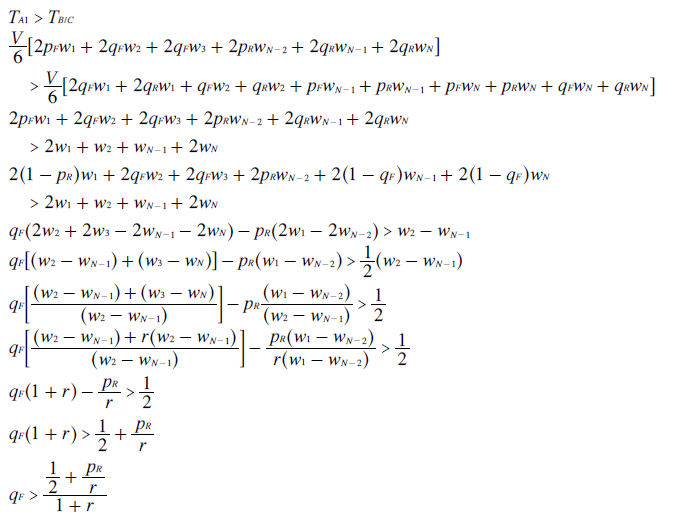Mathematical Proofs: Teaming Thresholds
Proof ET2: GV Teaming Thresholds for Clone Set versus Two Candidates
Scenario: The election is conducted using GV and its standard weightings are used here to determine the tally (T) for any of the N candidates on the ballot. The weighting of the first preference is set at one (w1 = a = 1) and the number of voters casting valid ballots is V. The clone set is A and it nominates K clones in total. On its forward slate, its clones are listed from A1 to AK. The reverse slate therefore lists these clones from AK to A1 in exactly the reverse sequence. In this second specific scenario, only two candidates B and C have been nominated to oppose the clone set A. All voters rank the clone candidates in either forward or reverse order.
- pF = Of those preferring A first, the proportion who rank the clone set in forward slate order
- pR = Of those preferring A first, the proportion who rank the clone set in reverse slate order
- qF = Of those not preferring A first, the proportion who rank the clone set in forward slate order
- qR = Of those not preferring A first, the proportion who rank the clone set in reverse slate order
Hence, for those preferring A first, pF + pR = 1 and, for those preferring B or C first, qF + qR = 1. Where all first preference A voters rank candidates in compliance with the forward slate, pF = 1 and pR = 0. Where they vote consistently for the reverse slate, pR = 1 and pF = 0. If no slate is issued and all clones are identical rather than fraternal, then pF = 1/2 and pR = 1/2. The same holds for first preference B and C voters except that the proportion p is now replaced by the proportion q.
For the clone set, there is no point in teaming if it would win anyway with just one candidate A. Therefore, its easiest opportunity to win unfairly through teaming is when it is tied with all the other competing candidates (B and C here). This pre-cloning critical tie between all candidates is where each has one third of first preferences, one third of second preferences and one third of third preferences (TA = TB = TC). After nominating its K clones, the profile for this election scenario is given below; using the standard notation and formats,
- pFV/6: A1,~~~,AK,B,C.
- pRV/6: AK,~~~,A1,B,C.
- pFV/6: A1,~~~,AK,C,B.
- pRV/6: AK,~~~,A1,C,B.
- qFV/6: B,A1,~~~,AK,C.
- qRV/6: B,AK,~~~,A1,C.
- qFV/6: B,C,A1,~~~,AK.
- qRV/6: B,C,AK,~~~,A1.
- qFV/6: C,A1,~~~,AK,B.
- qRV/6: C,AK,~~~,A1,B.
- qFV/6: C,B,A1,~~~,AK.
- qRV/6: C,B,AK,~~~,A1.
For clone A1 to win through cloning, the tally for A1 must exceed the one for B (or C); namely TA1 > TB/C. To maximise the tally for A1, clone set A should issue a forward slate to minimise the value of pR. To minimise this same tally, B and C supporters should reverse the slate to minimise the value of qF. By evaluating the tallies for A1 and B/C, this key relationship between qF and pR - the teaming threshold for A1 - can be derived as shown below.

The above teaming threshold determines the relative ranking of A1 and B/C as follows.
- For qF > (1/2 + pR/r)/(1+r), A1 wins through successful teaming against B and C.
- For qF = (1/2 + pR/r)/(1+r), B, C and A1 are all still tied.
- For qF < (1/2 + pR/r)/(1+r), B and C beat A1 through vote splitting.
For clone AK to win through cloning, the tally for AK must exceed the one for B (or C); namely TAK > TB/C. By evaluating the tallies for AK and B/C, the key relationship between qR and pF - the teaming threshold for AK - can be derived in exactly the same manner as above but with the F and R subscripts for p and q exchanged. This relationship is stated below.

The above teaming threshold determines the relative ranking of AK and B/C as follows.
- For qR > (1/2 + pF/r)/(1+r), AK wins through successful teaming against B and C.
- For qR = (1/2 + pF/r)/(1+r), B, C and AK are all still tied.
- For qR < (1/2 + pF/r)/(1+r), B and C beat AK through vote splitting.
Note that to beat A and remain tied in first place, B and C must simultaneously beat both A1 and AK.
Return to main text > Evaluations: Teaming Thresholds 2
Refer to > Mathematical Proofs: Table of Contents
